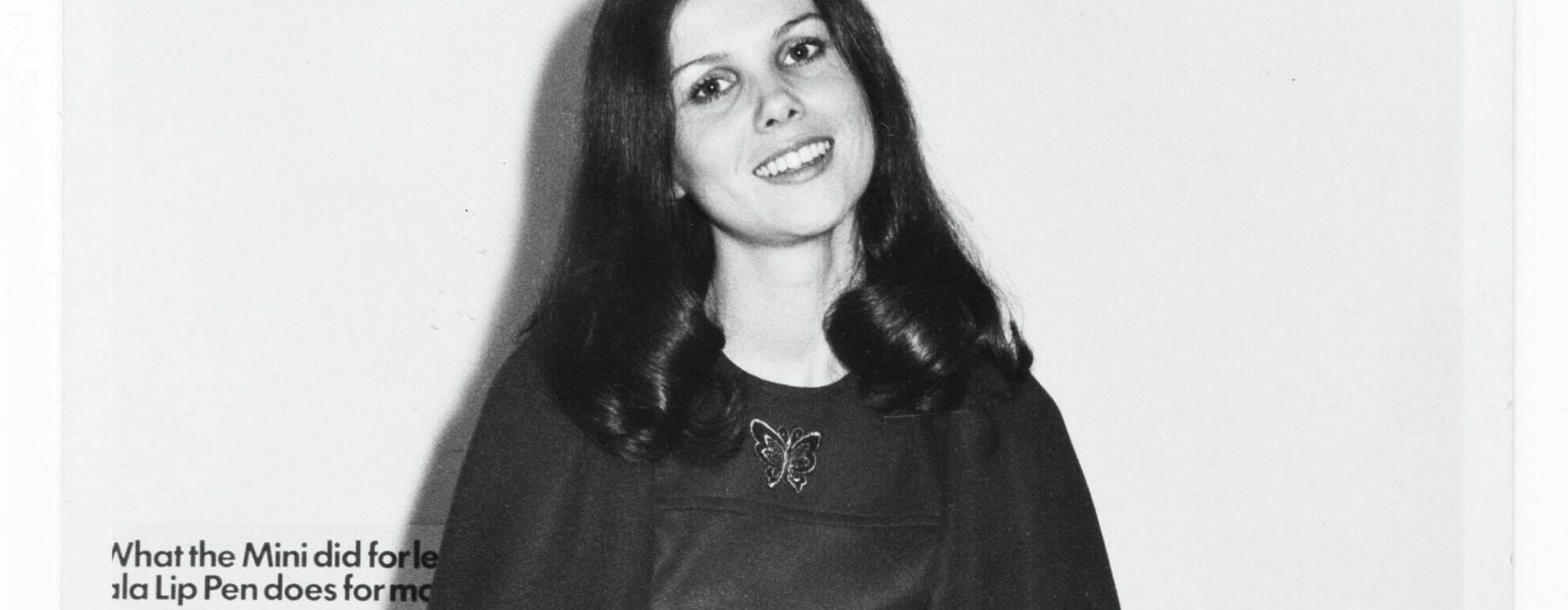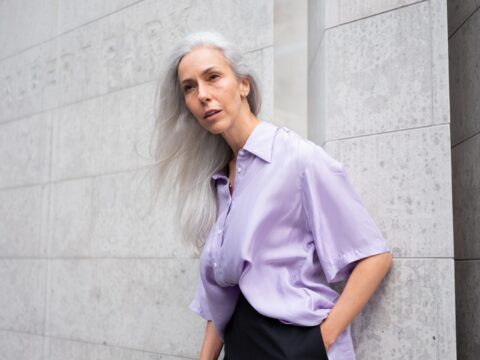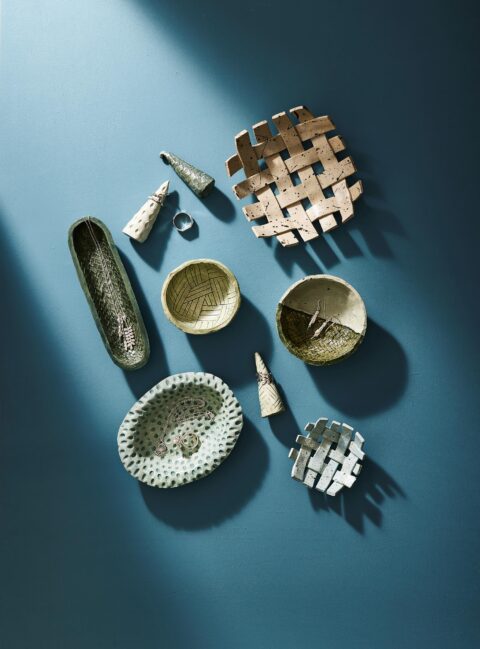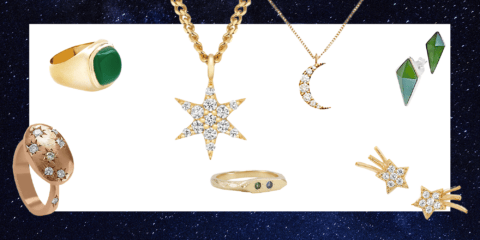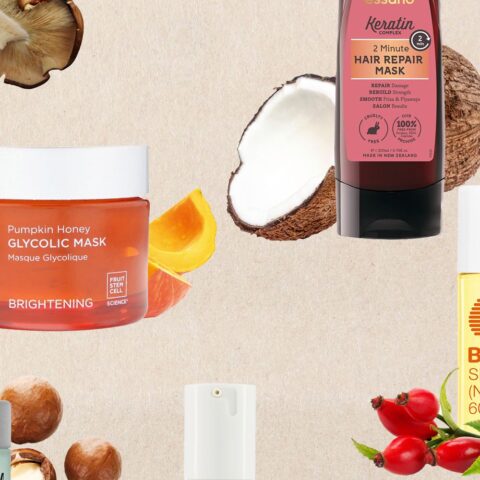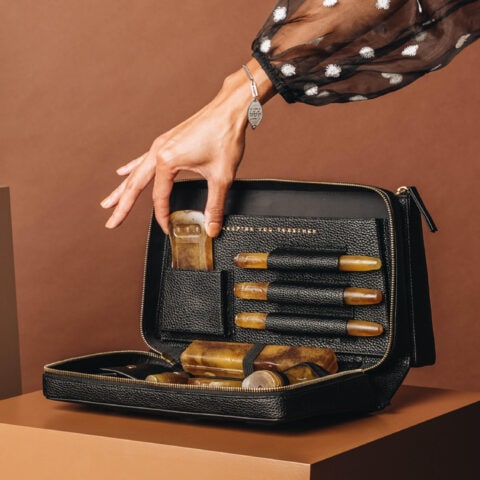Rowena Roberts in conversation with Sophie Matthiesson.
Having redefined London street fashion, by the mid-1960s Mary Quant declared “now that the clothes were different the face was wrong”. In 1966, she went into partnership with American-owned Gala Cosmetic Group to manufacture beauty products in Britain and embarked on an innovative campaign to market a constantly transforming range of make-up to the world. Auckland businesswoman Rowena Roberts was recruited by the company in the early days of the campaign, and here she talks about her memories of the Mary Quant project.
Sophie Matthiesson: Rowena, you’re the daughter of well-known musician Don Honeywill, and you grew up in Surrey, near London, in the 1960s. Can you describe what Mary Quant meant to you when you first came to work for her?
Rowena Roberts: She was amazing. I already knew about Mary Quant ahead of working for her in 1971. My sister and I went with our father to the BBC recording studios across London every week. My dad was a session musician in the ’60s, playing baritone sax and singing back-up vocals. He’s on the recording of The Beatles’ 1967 song All You Need Is Love, among many others. We went up to London a lot. We’d be in Chelsea and see all this psychedelia, and the amazing Kensington Market, so were quite used to what is known as the ’60s “scene”. Just before I finished college at 18, there was an advertisement in the paper for an assistant in the Mary Quant PR department. The cosmetics arm of Mary Quant was based near where my family lived, in Tolworth, Surrey. I saw the Mary Quant logo and I thought, “Whoa, okay! I might send in an application.” I had a great interview with Pat Mash, the Mary Quant international PR executive. I used to do modelling as a child; I told her about all that and about my dad. She asked me, “As soon as you finish college, can you start?”
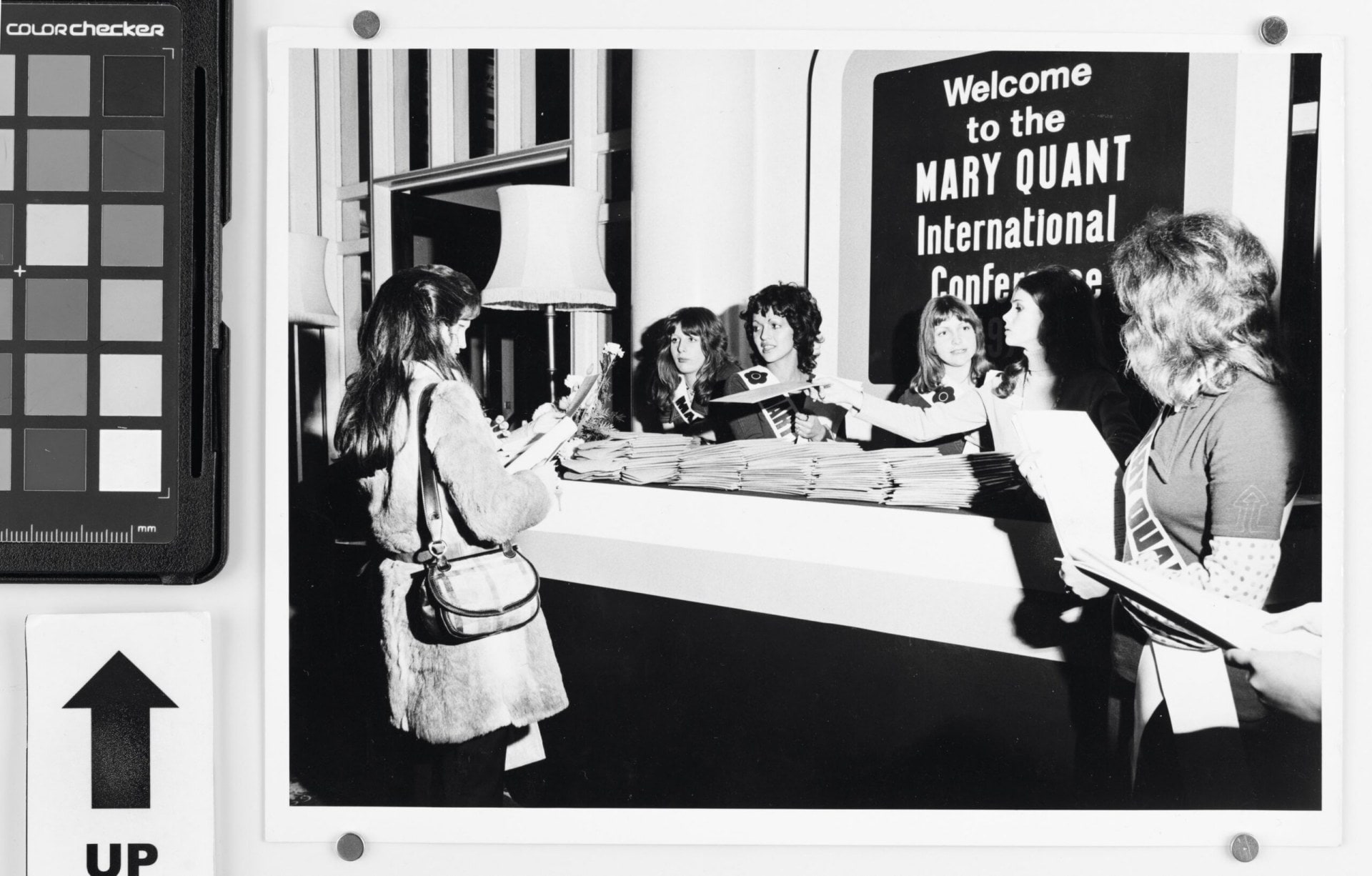
SM: In her autobiography, Mary talks about everything from the outset as being great “fun” and as an experiment in process. Did it really feel like that for an employee as well?
RR: It was just like a party. I started as soon as I finished college on July 26, 1971. I went in and I can remember exactly what I wore: a shiny white shirt mini-dress and high navy-and-white platform shoes. I walked in and everybody who worked there was pretty much under 30, a big young group. We were doing the international marketing and working with people overseas who sold Mary Quant. If someone like the buyer from Smith & Caughey’s came to the UK, we’d entertain them; two or three nights a week we’d be up in London because these buyers were all young and they all wanted to see Chelsea.
SM: Reading her autobiography, it sounds like Mary Quant had no personal braking or slowing-down mechanisms – she would just go for it until she was half dead, sick from exhaustion.
RR: When I started, I thought Mary was in her early 30s, but she was 41.
SM: The Quant brand was such a success. How much of this was spontaneous – catching a wave and just “the spirit of the times” – and how much was part of a grand or cunning plan? To go global, for example, was a huge undertaking. Is it truer to say there was a lot of hard work combined with good luck and good timing?
RR: I’d say there was a lot of that, but that she was probably the instigator of the timing. She was one of the first in there, and a lot of people went in on the back of her success. She was before the big ’60s music boom, which was probably 1964-66. At that time, Chelsea was amazing. You’d walk down the street and see people in these incredible clothes and cars with psychedelic colours, and the shop windows looking amazing. Mary Quant was already there with her shop Bazaar, on King’s Road, way before all that hit.
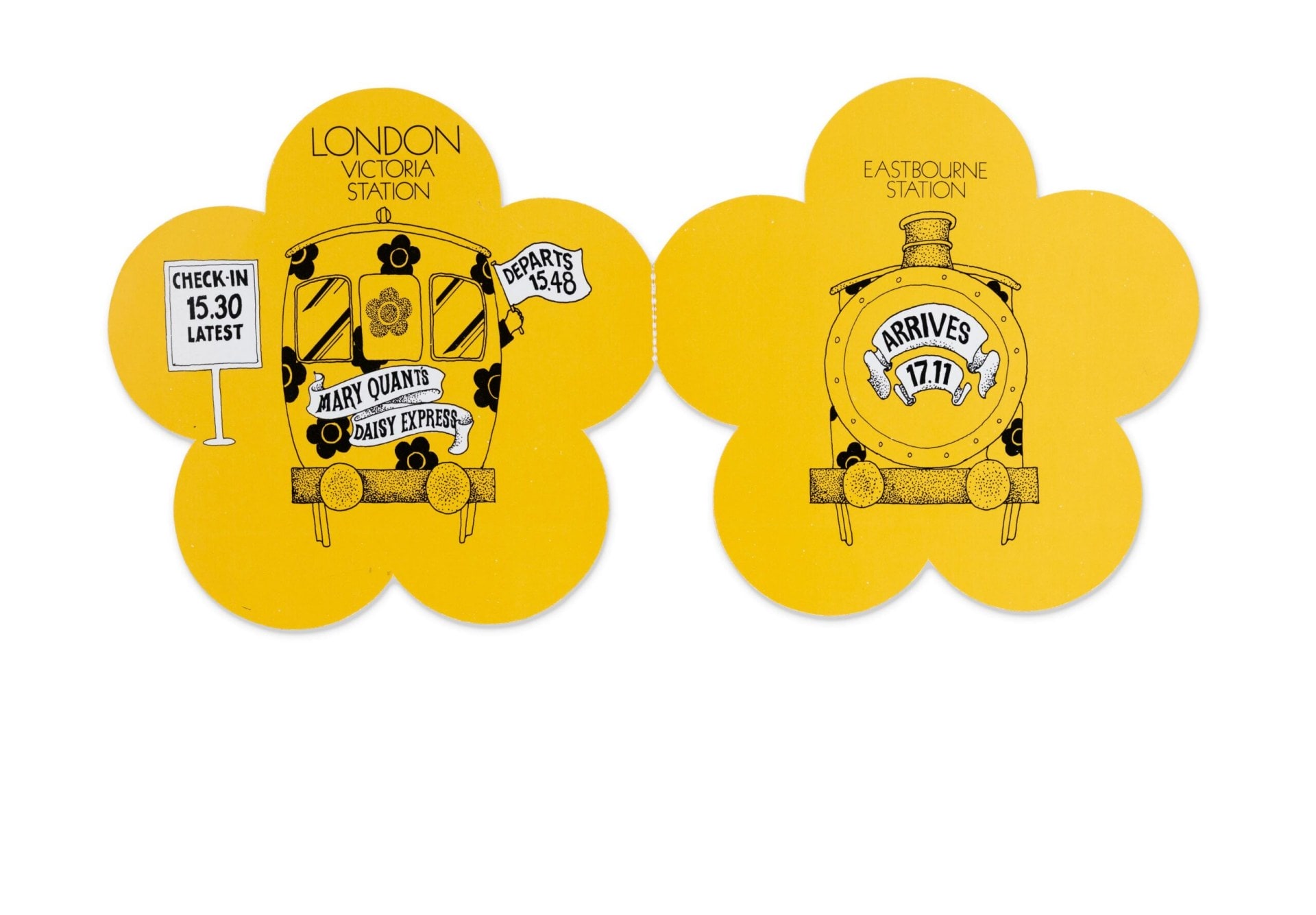
SM: How much of this could have happened without her personality?
RR: It needed personality. She only just started when women were still quite conservative, off the back of the war, and when people didn’t have money to spend. She knocked their socks off with her dresses and coloured tights.
SM: It seems to me she had no boundaries, in terms of how she thought; she had no inhibitions and that’s just magic for innovation. She had the confidence – what other young woman goes and talks to knitwear manufacturers and persuades them to do a super-long cardigan or a super-short dress?
RR: Absolutely. They were all still stuck in the housewifely twinset and pearls thing.
SM: Somehow she got industry people over the line. She must have talked so many people into doing something totally new.
RR: She was a lovely person and obviously she just had a total concept and she just knew, and she was determined. Her husband Alexander Plunket Greene played quite a big part in it too.
SM: There was family money there. But it sounds like Alexander hated boredom and she would have been a lot of fun. Clearly, he was an amazing person in his own right when she met him, when they were both very young. He had confidence and hated conventionality. And she had even more energy than him, didn’t she?
RR: They just never stopped, did they? They were cutting patterns when they opened their own little shop.
SM: One of the things that fascinates me is the question of class. Alexander was the cousin of the Duke of Bedford and the philosopher Bertrand Russell. For Mary to be middle class while her husband and his family were so wealthy, even aristocratic – that is in itself a huge thing. And then for her to go out and say things like, “Class is dead… Class doesn’t matter anymore… Class is so old school” – to me, that is remarkable. She must have had a lot of charm.
RR: She must have fitted in. I think also that the whole era was changing. Everything was changing. It was suddenly the pill. And it was music. And it was just expressing yourself, and you could wear what you wanted. And for a lot of people it was coming out of the war and the Depression. People had been using ration books; they had no money and couldn’t buy any clothes. They had to make do with things. And then, suddenly, there were all these colours and clothes, and they weren’t expensive because they weren’t made from silk and fancy fabrics. You could afford to buy things. And there was all the media. Suddenly you had magazines like Honey, Petticoat and Seventeen, and the new mood was across everything.
SM: Everything I learnt about Mary in the autobiography rings true and made me like her so much. She says, for example, that you are ruined if you have prima donna behaviour. Well that’s true, isn’t it? She is very direct. In interviews, she talks straight to the camera and it’s as if she has no age, you have no age, it doesn’t matter who you are. She is just a born communicator. Something that my colleagues have been musing about is the fact that she wasn’t tainted by sex, drugs and rock ’n’ roll. She had a clean image.
RR: She wasn’t tainted at all. It was such a normal part of that whole ’60s vibe, but I guess she was slightly older. She was in her late thirties when The Rolling Stones were in their mid-20s and at the height of their fame, and she had a young son.
SM: Looking back, what were the highlights during your time working for Mary Quant?
RR: Well, the Mary Quant Beauty Bus – that whole thing happened not long after I arrived. I was thinking, “What a job this is!” We were getting photographed. The make-up artists used to come and sit in the office. I worked on a big international conference in Eastbourne for Mary Quant delegates from across the world. It was lovely. We took over a train at Victoria Station and decorated a whole carriage for the launch of “Special Recipes”. We covered it in yellow and white daisies. The conference ran for three days, and Mary came down for that. It was just a blast and we all had Mary Quant dresses on. I had a dress that was see-through; it was a grey colour with red and white flowers and a matching bikini underneath. Looking back, there didn’t ever seem to be any kind of budget. Imagine taking over a train carriage and how much that would have cost!
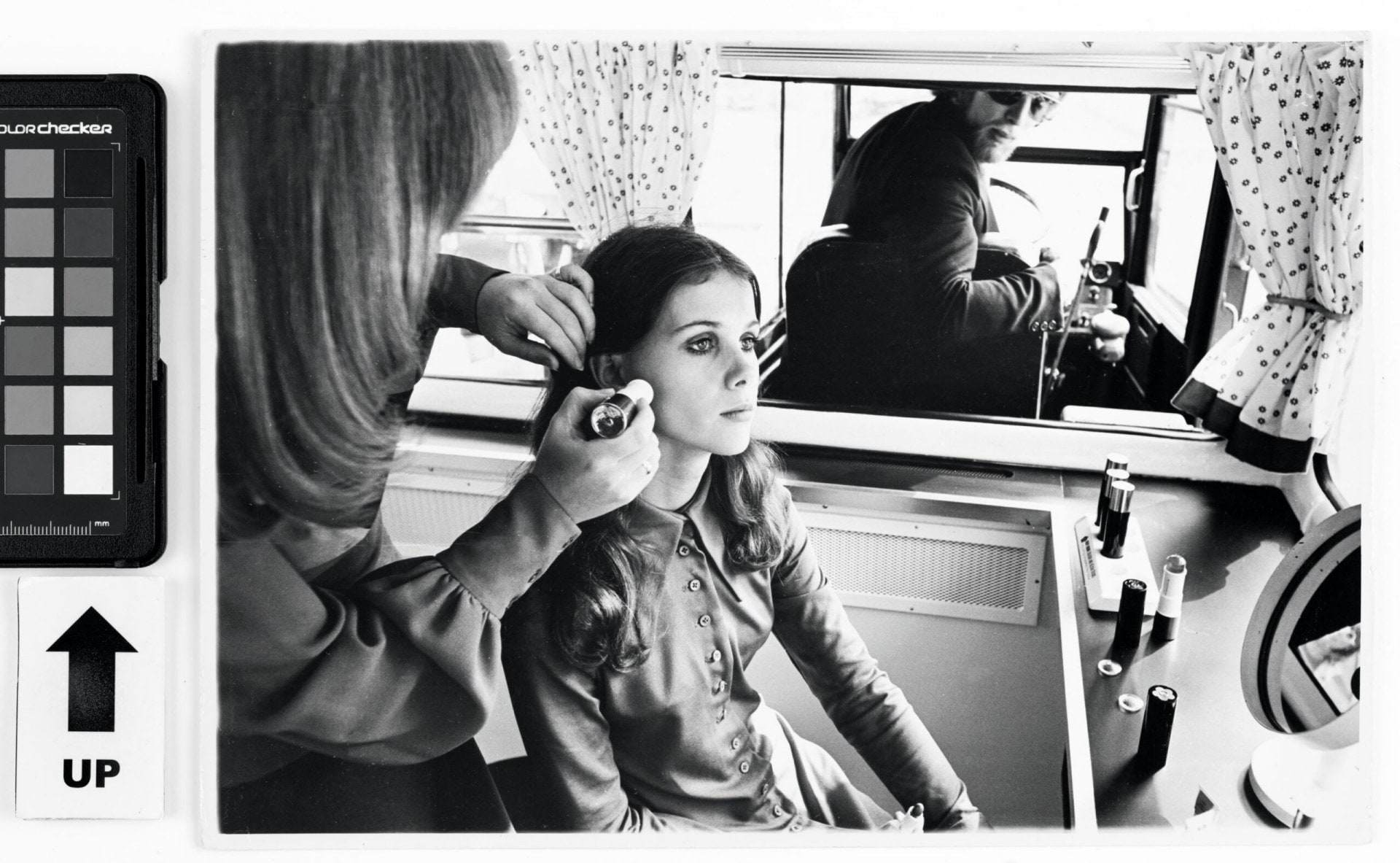
Rowena being a make-up demonstration model in the Mary Quant Beauty Bus in 1971.
SM: In a funny way, it’s good business really, isn’t it? Because if the staff are having fun, everyone else just wants to be part of it.
RR: Yes, “Count me in. I want to be part of that!”
SM: Because it’s the opposite of the idea of a London 9-5 job.
RR: Yeah, it was Swinging London!
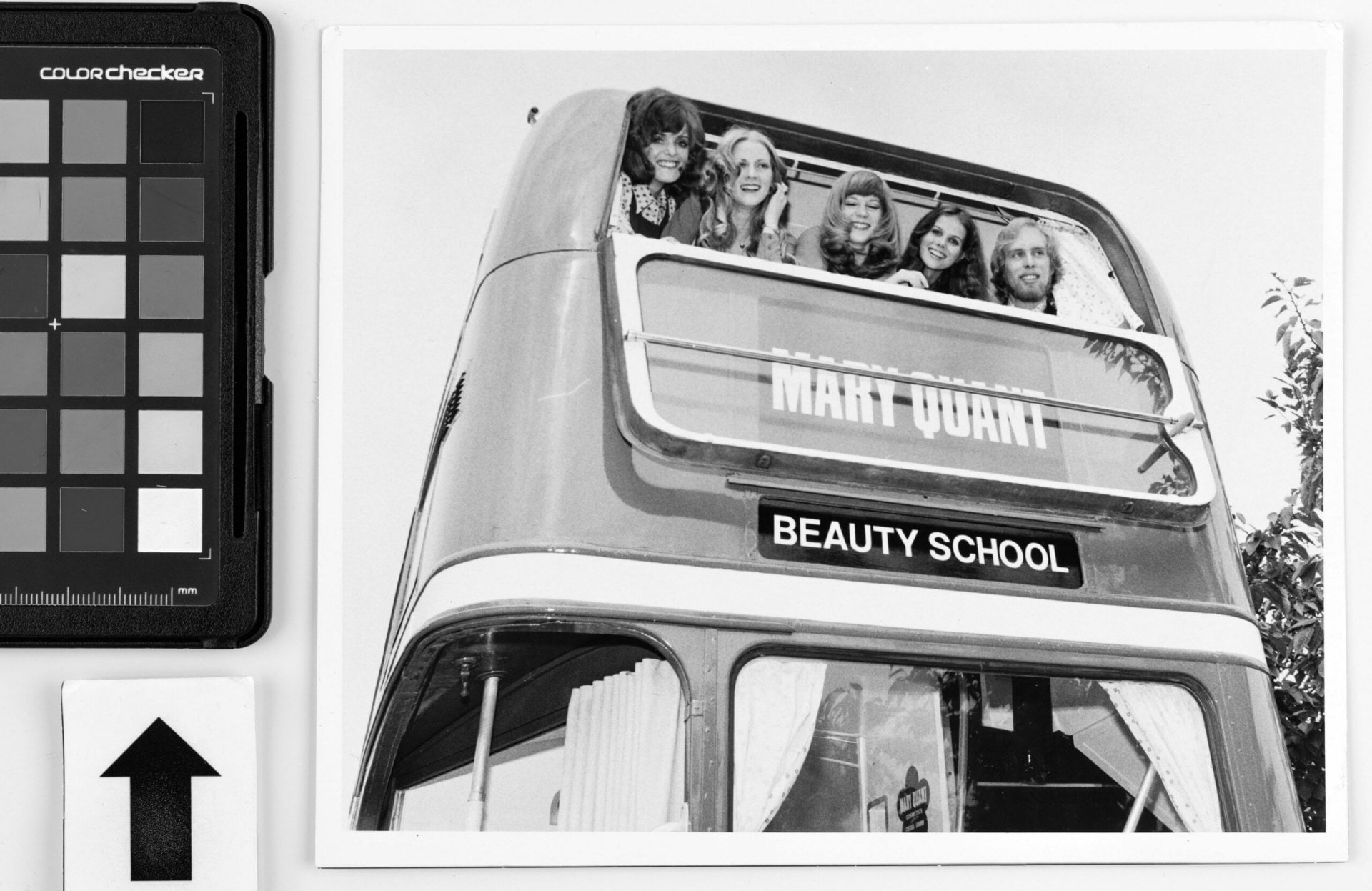
Like Mary Quant’s fashion, the London double-decker Routemaster bus was a triumph of British design, centred on ideas of modern post-war efficiency. In 1971, Gala Cosmetics purchased a bus from London Transport’s fleet as a mobile showroom for make-up products. The Mary Quant Beauty Bus was stripped and custom-fitted with long make-up tables, mirrors and swivel stools for training sessions. The bus would park outside a Mary Quant cosmetics stockist and offer training in the latest make-up colours, products and application techniques, with clients taking away a list of suggested products. Between 1970 and 1975, the Mary Quant Beauty Bus travelled through Europe, Canada, the USA and Venezuela.

